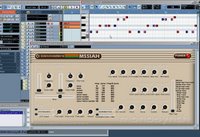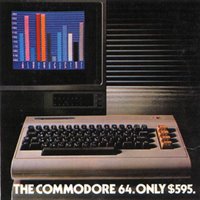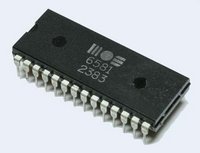I realised early on that interacting with my newly purchased MSSIAH cartridge wasn’t going to be easy. In the old days I used a portable TV to see what was happening on the C64, but the last thing I need in the studio is another big box taking up space. I briefly looked into connecting a flat panel VGA screen, but quickly discovered that it’s not possible without some incredibly expensive outboard equipment.
I did discover however that the later C-revision of the Commodore 64 (C64C) had a fully compliant S-Video output on the back. So perhaps an external flat panel TV with S-Video input would work. Although that quickly led me on to another idea – a USB capture device! In a nut shell, the C64 plugs into the USB dongle, which plugs in to the PC, and I see the C64 display on my screen using some capture monitoring software called DScaler.
It was with some disappointment that I found out that when in MIDI mode, the MSSIAH blanks the screen, so you can’t see what you’re tweaking. NOOOOOoooooo ! I’m sure this is done to save on CPU cycles, but goddamn it’s annoying!
All is not lost! The MSSIAH supports the use of four external potentiometers, also known as pots, or just plain old “knobs” to everyone else. These can be configured in MSSIAH to control any four controllers, as most people will only be tweaking the filter, this fairly usable.
Upon closer inspection of the manual, I found the MIDI controller table in the last few pages. With my first few bits of MIDI kit, this confusing table went largely ignored, as I’m sure is the case for many people. But if you want to get into the details it can make life a lot easier, by being able to build your own patch lists, or by knowing which controller signal to adjust in Cubase to make adjustments to your sound (or let’s be honest, to correct a bit of over ambitious knob twiddling).
 It also means, that if you’ve really got a lot of time to spare, or are waiting for your USB Capture device to arrive, you can build a MIDI Device Panel for Cubase. So that’s what I’ve done! I think you’ll agree, it looks pretty flipping good too! Click on the image to the left to see a screen shot of my Cubase MIDI Device Panel for MSSIAH MonoSynth in action.
It also means, that if you’ve really got a lot of time to spare, or are waiting for your USB Capture device to arrive, you can build a MIDI Device Panel for Cubase. So that’s what I’ve done! I think you’ll agree, it looks pretty flipping good too! Click on the image to the left to see a screen shot of my Cubase MIDI Device Panel for MSSIAH MonoSynth in action.
This has gone through a few changes while I was developing it, mainly due to the eccentricities of the Cubase Panel Designer which turns out to be functional, but fairly uninspirational and full of bugs.
You’ll see that all of Monosynth’s main adjustments for I mentioned in my last post are here. I’ve also added the ability to save presets. This means you can build a repository of your favorite C64 sounds. I’ll be honest; there is a slight problem with this side of things which means that whenever you load a preset, not all of the values are loaded. I think this is because Cubase fires all of the controller info over in one go, and MSSIAH just can’t interpret all of that information quick enough, and misses some things. This means that if you move from one patch to another, you often end up with a sort of hybrid of the two sounds. You actually end up with some interesting sounds sometimes, but I’d much rather it worked. If anyone knows how to slow Cubase down, please leave a comment on how to do this! In the meantime, of you click on the same patch two or three times, eventually you get something which more closely resembles the sound you stored in the preset.
I’ve made my work freely available for download here. You should right-click, then SAVE AS the file. To use it in Cubase, open up the MIDI Device Manager and click Import Setup, then browse to the file.
You can use this as a basis for your own MIDI panel, but if you do, please give me credit for all my hard work! A simple reference to www.rebornonline.com will do! Either a link from your website download page, or by putting www.rebornonline.com on your graphic….or both if you’re feeling particularly grateful!


